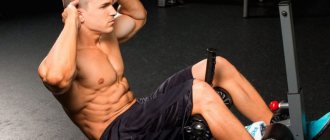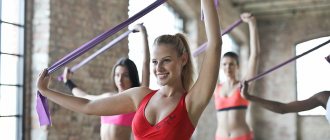Home > Blog > How many times a week should you stretch?
Stretching is a set of muscle stretching exercises that allows you to develop joint flexibility, elasticity of tendons and ligaments. Classes are necessary for athletes and ordinary people who do not have special physical activity, and are carried out as part of the prevention of diseases of the musculoskeletal system. Before training, you should learn about the types of stretching and how many times a week you need to stretch to achieve results.
Benefits of regular exercise
The main benefit of stretching is improving coordination of movements, flexibility and plasticity of the body. The benefits of exercise include:
- reducing the likelihood of injury;
- improving the quality of movements, which is important for dance training and fitness;
- elimination of back and lumbar pain;
- normalization of blood circulation.
In addition, a great mood appears, and it becomes easier to do everyday activities, choreography and various sports.
Disadvantages of evening classes
Fatigue often sets in by this time, especially if the day is eventful. This provokes a decrease in motivation and refusal to attend training. Although this opinion is subjective. Either way, it's a great way to relax and get rid of negative energy.
Another problem with evening classes is the difficulty in choosing the time for the last meal. You shouldn't exercise after dinner, and a heavy dinner after training will ruin all your efforts. The best way is to refuse to eat food altogether, replacing it with kefir, and not everyone can do this. On the other hand, stretching is more aimed at building muscle definition rather than at losing weight, so it makes no sense to deny yourself a light dinner.
Types of stretching
There is a soft and deep type of stretching. In the first case, the muscles are stretched only to their characteristic length. The deep look involves stretching to an unusual length.
For beginners, it is better to start with static exercises.
Types of stretching:
- Static is ideal for beginners. The point of the exercises is that the muscles are tensed and kept motionless for some time.
- Dynamic - similar to static stretching, but the muscles first tense and relax after a certain time.
- Active - muscles that are in a passive state are stretched by the work of surrounding muscles.
- Isometric - the exercise is based on the principle of resistance and is performed in four stages: tensing and relaxing the muscles, and then stretching them and fixing them in a new state.
- Ballistic - ideal for people who do not have good stretching, this type will not work. There are rapid movements with a sharp increase in amplitude.
- Proprioceptive neuromuscular - the main task is to restore joint mobility after injury, illness or surgery. Represents physical therapy.
To answer the question of how many times a week you need to do stretching, you should consult with a specialist, especially when it comes to proprioceptive neuromuscular training. The doctor will determine the optimal number of sessions.
Stretching exercises
I Neck stretching
- Tilt of head to the sides
To stretch your neck muscles, you need to stand up straight and tilt your head back. Then tilt your head to the left and place your left hand on the top of your head. Apply a little pressure on your head, and try to resist with your neck muscles. Maintain static voltage for 15 seconds. Next, tilt your head to the right and repeat the same thing, but for the right side of the body.
- Tilt your head diagonally
Stay in the starting position. Now tilt your head forward and slightly to the right side. Place your left hand on your head and add a little force. Create pressure for 15 seconds, and then do the same, but tilting to the left.
- Top of head up
Standing straight, clasp your head with your hands so that one hand holds the top of your head and the other holds your chin. Keeping your neck straight, try to point the top of your head as high as possible. You should feel tension in the back of your neck.
II Shoulder stretching
- Exercise "castle"
Stand up straight with your hands behind your back. Place your hands behind your back, pushing your chest forward as much as possible. Keep your wrist as high as possible.
- Mid Shoulder Stretch
Now we stretch the middle part of the shoulders. Standing straight, straighten one arm to the side. With your opposite hand, grab your elbow, trying to help straighten your arm as much as possible. Hold in the maximum position for 15 seconds. Then repeat the same thing, but with the other hand.
- Let's stretch the back of the shoulders
The starting position is similar to the previous exercise, only now the straightened arm should be directed upward. The opposite arm should be straight on top and offer resistance. Hold this position for 15 seconds. Then change the working hand.
- Triceps stretching
This exercise is good to perform after excessive strain on the triceps to relieve pain.
Stand near a wall, raising your arm bent at the elbow and placing it behind your head. With your other hand, grab your body. Your hand should rest below your armpit. Come close to the wall and lean your elbow on it. Stretch first one hand, then the other.
- Biceps stretching
Now we stretch the biceps. Find a stand or any similar support. Stand with your back to it, move your arms back and grab the support. Bend your body forward, stretching your biceps muscles. Stretch for 30 seconds. You can grasp the support with both hands or alternately.
- Triceps stretching
This exercise is nothing more than the well-known “lock”. Standing straight, you need to put your hands behind your back and fold them into a lock. Bring your hands together at the shoulder blades. Perform the exercise with different hands alternately.
- Wrist stretching
To perform this exercise, you need to sit on the floor and place the backs of your hands on the floor. Lean forward, placing your body weight on your hands. If this exercise seems too easy for you, try clenching your fists additionally.
III Chest stretching
- Stretch in the doorway
You need to stand facing the doorway, leaning both hands on the doorframes. Place your entire body on your hands, pushing your chest forward. Feel the maximum stretch in your chest muscles.
- Stretching the pectoral muscles against the wall
Stand sideways near a wall. Place it on her hand and turn as far as possible in the opposite direction. Repeat with both limbs.
IV Back stretching
- Stretching near the support
Stand sideways near the counter. Grasp the support with both hands and arch your back to the side. One hand should be above your head. Push your pelvis as far to the side as possible. Approach the support from the other side and do the same thing, but in the other direction.
- Sitting back stretching
Sit on the floor and bend your knees. With your feet slightly apart, lean your body forward until your head is between your ankles. Wrap your arms around your limbs. Your wrists should be on your feet. The back remains rounded during the exercise.
- Child's Pose Back Stretch
Sit on the floor on your knees. Bend your body forward, stretching your straight arms forward. Try to straighten your arms as far as possible without lifting your buttocks from your heels.
- "Downward Facing Dog"
This exercise is borrowed from yoga. You need to get on all fours on the floor, and then point your pelvis as high as possible towards the ceiling. Your arms should be straight and in one line with your back. The back will thus remain straight without bending. Hold this body position for a while.
- Inverted stretch
For more advanced athletes, a more “acrobatic” exercise in an inverted position is possible. To begin, lie on the floor with your legs straight. Lift both legs up and behind your head, supporting your body position with both hands. Placed at the waist. Don't lean on your neck. Your fulcrum should be your shoulders.
V Abdominal stretching
- "Camel"
Kneel on the floor and bend your back. Your hands should touch your feet. The maximum deflection is in the chest. Stay in this position for 30 seconds.
- "Upward Facing Dog"
Lie on the floor on your stomach and raise your upper body with support on your palms. Your feet should remain on the floor and your pelvis should rise slightly. The deflection is in the thoracic region. Hold the pose for 30 seconds.
- Side bends
Static side bends are also a good way to stretch your oblique abdominal muscles. Clasp your hands and bend to the side. Stretch as far to the side as possible. Be sure to do the exercise on both sides of your body.
- Crunches on the floor
Lie on the floor with your legs straight. Then bend one knee and place it on the opposite side of your body. The upper body remains motionless on the floor, with arms spread to the side. After holding the static voltage for 30 seconds, switch sides.
Contraindications for stretching
Every sport has contraindications, stretching is no exception. People should not do it:
- With recent fractures - if your cast has been removed, this does not mean that you immediately need to run to training. The bones should recover, after which stretching can begin.
- With dislocations , you should wait until the ligaments return to normal.
- With problems of the cardiovascular system, joints and spine.
Expectant mothers also need to be careful about stretching. If there are no problems with the course of pregnancy, there are no other contraindications, then stretching will only be beneficial and will help prepare for childbirth. Of course, the exercises are performed under the close attention of the instructor.
It is recommended to attend training 2-4 times a week, devoting 30-50 minutes to classes. Stretching is not just a five-minute warm-up before the main power loads, but a full-fledged activity that requires a sufficient amount of time, because this is the only way to achieve success.
What are the benefits of individual lessons at a pole dance school in Moscow?
In addition to a personal trainer and a carefully selected training program, individual training in a stretching studio will allow you to achieve the desired results as quickly as possible and just have a good time. You don’t need to be distracted by anyone or embarrassed by strangers, the instructor’s full attention is for you. In addition, stretching has a wonderful ability to relieve stress and fatigue. Even after work, stretching classes will make you feel rested and relaxed.
Our studio provides its students with all the necessary amenities. In addition to the bright hall, you will find a ladies' room, changing rooms, shower, minibar and Wi Fi. And after class, you can always have a cup of tea and an interesting conversation with your instructor.
How to exercise correctly
An intensive warm-up will help your muscles do their best when performing complex elements.
Before training, warm up your muscles and prepare for the exercises. It is important to maintain even breathing. Do not stretch through the pain, because this is fraught with injuries and dislocations. Only mild pain that does not cause discomfort may be present. You need to stretch all muscles and spend the same amount of time on them.
The form of clothing plays a big role. Choose tracksuits made from durable materials: polyester, nylon, elastane. It is better to exercise in tight-fitting clothes, which help distribute heat throughout the body, which helps eliminate extra pounds. At the same time, follow your sleep and nutrition schedule.
Any stretching session consists of a warm-up, special exercises for flexibility and stretching, and muscle relaxation. The main thing is to train regularly, without skipping, and consult with doctors about contraindications. Then the answer to the question of how many times a week you need to do stretching will not cause difficulties.
Remember Compensatory Exercises and Symmetry
The human body is a complex biomechanical system regulated by brain signals. It is impossible to stretch the body in one place without consequences without destroying the balance.
Balance requires stretching opposite parts of the body as well. For this, there are special compensation exercises that should be used immediately after some stretching.
And, of course, the body should be stretched symmetrically, giving equal attention to each limb or half of the body. If you stretch your right leg for 10 minutes, be so kind as to stretch your left leg for the same amount. Nothing less. Only in this case can you count on the benefits of stretching exercises.
Look at the stretching with Ekaterina Firsova on the blog - you can’t help but like this complex! She will teach you how to pull the twine correctly!
Stretching with Anix Dance school trainers
The Anix Dance pole dance studio invites everyone to attend stretching classes. Professional instructors will help you improve your physical condition, recover from injuries, and adjust your weight. The training programs are designed in such a way that the necessary muscle groups are worked out, and the results are noticeable after just a few sessions.
You can choose a training schedule that is convenient for you. We provide the opportunity to study both in a group and individually. Group training will allow you to meet new interesting people and achieve your goals together with them. Individual lessons are suitable for those who want to concentrate on stretching and perform exercises under the supervision of a teacher.
Don't suffer pain when stretching
Often, stretching exercises for a rigid body are so painful that many simply cannot stand it and quit this activity. Is it possible to stretch without pain?
You should know that stretch marks should never be painful. This is the direct and shortest route to a hospital bed. And for a long time.
But stretching shouldn’t be too pleasant if you want to get serious results in the foreseeable future. No severe pain is the first rule when training flexibility.
When is it better to do stretching, morning or evening, depending on the load?
Morning exercises are considered more effective
If free time is not limited, then you can choose the training time at your own discretion. There is no point in figuring out when it is better to do stretching, in the morning or in the evening, with a free schedule. It is better to focus on your own feelings. The body itself tells you whether it is more comfortable to lie in bed in the morning or to start the day with a workout that will invigorate, refresh and give positive emotions.
It’s much more difficult if the day is spent working or studying, then there are no alternatives left. But this does not mean that evening classes are inferior in quality to morning ones. Try to overcome laziness - and you will see that regular training gives positive results within a few weeks.











